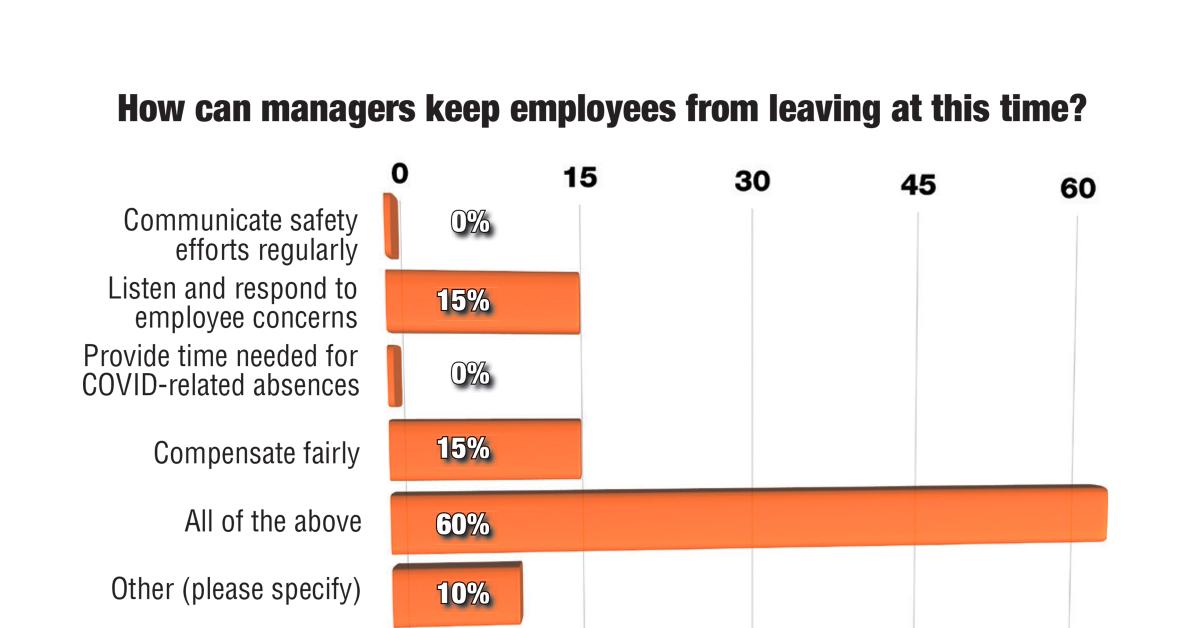CHICAGO — The COVID-19 pandemic has made finding and retaining employees difficult in laundry and linen services.
That’s the result of the most recent American Laundry News Your Views survey.
When it comes to hiring employees, 85% of survey respondents indicate their laundry operations have had difficulties since the pandemic began. Only 15% say they haven’t had problems.
Overwhelmingly (83.4%), those who took the survey indicate that the availability of government assistance has kept potential employees from applying for job openings, instead of other factors such as stay-at-home orders, fear of infection, the need to stay home and care for family members, and not understanding the importance of the job.
“It has honestly been a combination of all the above,” writes a respondent. “When employees don’t feel valued, they get discouraged. But currently, the government has made it very easy to stay home and not seek out employment opportunity, although we have quite a bit!”
So, how are laundry operators trying to attract employees? Some ways survey takers indicate include:
- Benefits with pay and post-COVID opportunities.
- Changing the marketing strategy to attract a different audience.
- Salary increases, attendance bonuses, sign-on bonuses and referral bonuses.
- Job postings.
- Online and social media.
- Staffing agencies, advertising, EDD (Employment Development Department), flyers, word of mouth, bonus pay for referrals.
- Using temp help agency.
One survey taker says, “We pay them more than others to hire them, and to keep the old ones.”
Keeping employees has been somewhat of a challenge for laundry operations, too. When asked if they’ve struggled to retain employees, 70% of respondents say yes, while 30% indicate they haven’t had issues.
The reasons laundry employees are leaving vary. Reasons survey takers have received include:
- Those willing to work are leaving for better pay or perceived lower-risk work.
- Overworked.
- Higher salary/benefits.
- Some leaving for restaurant jobs or other industries.
- Not happy with type of work. There's plenty to choose from.
- Stay home and make more money between unemployment and government assistance.
- Family issues.
When asked how managers can keep employees from leaving at this time, 15% of respondents indicate both “listen to, and respond to, employee concerns” and “compensate fairly.”
The top response to the question was “all of the above” at 60%, which includes “communicate safety efforts regularly” and “provide time needed for COVID-related absences.”
One challenge resulting from the COVID-19 pandemic has been unexpected absences, whether due to symptoms, exposure to the virus or the need to care for family members. In order to cover these unexpected absences, 90% of respondents indicate their company cross-trains employees on various laundry equipment.
“We cross-train because it allows us to have coverage for unexpected absences or surge of business,” writes one respondent. “When one area slows down, the employee can be transferred to another area/department requiring help. making it a win-win.
“Both the employee and employer win, which allows the employer to ensure the customer is receiving all their linen order completely and as scheduled.”
“Cross-training is an easily implemented redundancy system and helps alleviate boredom in a very repetitive work environment,” writes another.
Another respondent admits, “We could do a better job at cross-training to have coverage when associates are out.”
One of the 10% of survey takers whose company doesn’t cross-train writes they don’t because of “equipment abuse or chemical safety. These are tightly held positions, and employees don’t want night shift when production is done.”
“I believe that the biggest asset is to remember employees are our inside customers, train, teach them, show them, be an example and most of all communicate,” writes a survey taker. “There should be transparency so everyone understands they are vital to the operation and bring value, in my humble opinion.”
“Come September, there will be a flood of available employees,” writes another.
While the Your Views survey presents a snapshot of readers’ viewpoints at a particular moment, it should not be considered scientific. Due to rounding, percentages may not add up to 100%.
Subscribers to American Laundry News e-mails are invited to take the industry survey anonymously online each quarter. All managers and administrators of institutional/OPL, cooperative, commercial and industrial laundries are encouraged to participate, as a greater number of responses will help to better define operator opinions and identify industry trends.
Have a question or comment? E-mail our editor Matt Poe at [email protected].


